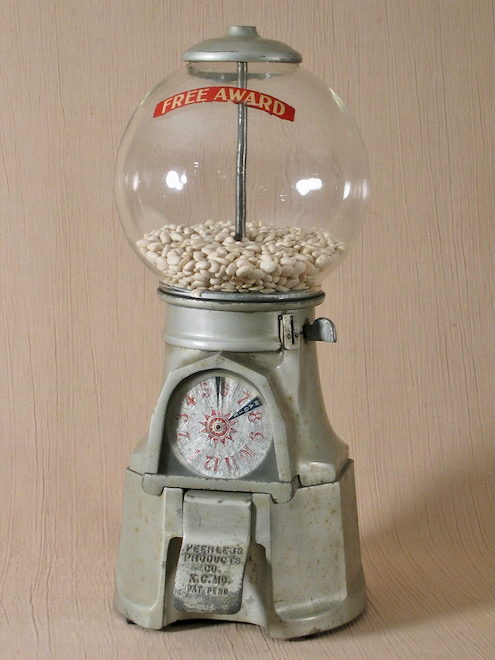___________________________________________________________________________________________
Bluebird Magic Vendor

___________________________________________________________________________________________

Bluebird Products Co., Kansas City, MO, pat. 1935, 18". With a patent date of 1935, this seems to be a later Bluebird model than most. It's also more elaborate than most other Bluebirds. Designed to dispense bulk product such as peanuts or small candies, from the vending wheel up it looks like a Bluebird Bulk Vendor, but the part below the vending wheel differs.
Putting a coin in and pulling the lever causes the numbered wheel to spin. The wheel has 12 numbers and a wedge marked "MATCH." At least two other versions of the Magic Vendor have 32 numbers. Silent Salesmen Too, page 26, shows the model above alongside the two versions with 32 numbers and says that "your chances of winning on any of the machines was about 1 in 32." I don't know how winners were selected, but given the probability that Bill Enes states in Silent Salesmen Too, I assume that only a MATCH won anything on this machine. I don't have a version with 32 numbers; looking closely at the pictures in Silent Salesmen Too I don't see a wedge for MATCH, but the pictures aren't large enough to discern what's written on the wheels. Maybe MATCH is written but it's too small to see, or maybe the setup for the 32-numbered versions was to compare the number selected by the machine against winning numbers listed on a marquee on the machine or on a placard near the machine. If your number was a winner, then you won!---although I have no idea what you won. For those of you who've read this far, I want to repeat my words from this paragraph's fifth sentence---"I don't know how winners were selected"---and ask that you bear them in mind as you read my speculations.
The example above is 100% original.
___________________________________________________________________________________________
___________________________________________________________________________________________
©Small Vintage Vending 2021